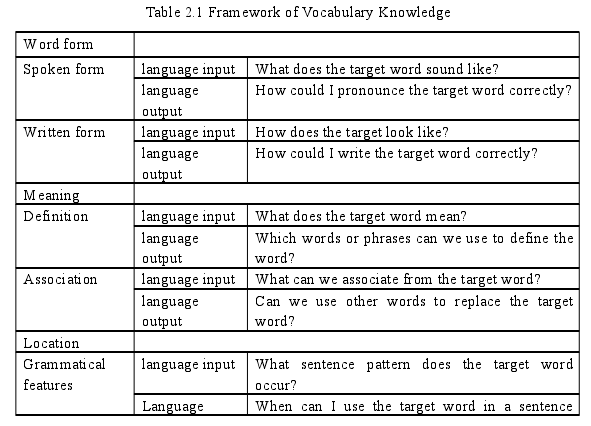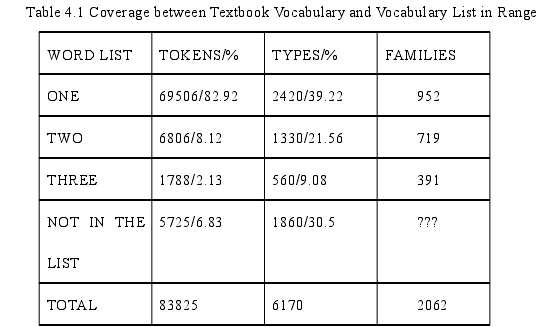Chapter 1 Introduction
1.1 Research Background
Vocabulary plays a vitally significant role in second language learning. Itsustains pronunciation and grammar, being the cornerstone for language learning.Allen & Vallet (1972) stated that no matter what target language one learns,vocabulary is the significant factor in all language learning and teaching. Just asWilkins (1972) said, without grammar, little can be conveyed, but without vocabulary,nothing can be conveyed. Dellar & Hocking (2000) believed that if students spent toomuch time on grammatical features, their language ability cannot be improvedobviously, while if much attention was paid to learning vocabulary, they wouldwitness a tremendous progress in language proficiency.
Although it is generally accepted that vocabulary is indispensable in languagelearning, it was not until the later 1980s that the significance of vocabulary in Englishlearning has been generally recognized by textbook compilers. Before the 1970s, littleattention has been given to the presentation of vocabulary in textbooks. It was thepublication of the first edition of The Cambridge English Course that pioneered theimportance of vocabulary in textbooks. From then on, scholars from differentcountries conducted tremendous researches of vocabulary in textbooks. Some of themstated the impacts of vocabulary on learners’ language proficiency. Others focused on evaluating vocabulary in textbooks, including the presentation of vocabulary incertain textbooks, comparison between the vocabulary in certain textbooks and thevocabulary list in curriculum standard. With the development of corpus linguistics,the use of corpus in vocabulary evaluation attracted attention of many scholars.Unlike previous ways of evaluating textbook or vocabulary in textbooks, corpusanalysis is more objective and more scientific due to its nature. Therefore, more andmore scholars started to analyze textbook or vocabulary in textbooks based on corpus.
.............................
1.2 Research Purpose
The purpose of this research is to investigate the vocabulary in new Englishtextbooks for senior high by PEP and then to provide practical suggestions tofront-line teachers and textbook compilers. To be specific, in the breadth ofvocabulary, this study aims to figure out to what extent vocabulary presented in textbooks covers the words in Range’s three basic word lists and to what extent it is inline with the word list in NECS (2017 version); in the depth of vocabulary, it aims tomake it clear that whether the new textbook presents the most commonly useddefinitions and collocations of vocabulary so as to facilitate learners’ vocabularyacquisition.
Combined with literature analysis, this research analyzes the vocabulary oftextbooks in senior high by PEP. As new textbooks have just been published,researches on evaluation of new textbooks are still scarce. This study will enrich thestudies on the new textbooks and provide pioneering references for subsequent studiesin this issue. In addition to this, by using corpus analysis, a more scientific way ofevaluating textbook, this research will also provide insight for teachers in middleschool to evaluate textbooks.
.............................
Chapter 2 Literature Review
2.1 Definition of Key Terms
2.1.1 Textbook
Concerning definition of textbook, there are mainly two types: the broad one andthe narrow one. In a broad sense, according to Cheng (2002), it refers to all kinds ofteaching materials used in or out of a class, including textbook, workbook, videos,cards and real objects used to facilitate teaching and learning. While in a narrow sense,according to Cheng (2002), it refers to textbook compiled according to the guidanceof NECS (2017version) or national instructional syllabus and the real needs ofstudents. In this study, it refers to the narrow one.
2.1.2 Vocabulary
When it comes to definition of vocabulary, it is indispensable to make thedefinition of a word clear. According to Zhang (1999), a word is “a minimal free formof a language that has a given sound and meaning and syntactic function.” Therefore,vocabulary means “all the words in a language”. McArthur, Tom (1992) made asimilar definition. According to him, vocabulary refers to “all the words in a languagethat are understood by a particular person or group of people.” Based on previousdefinitions of vocabulary, in this study, the definition of vocabulary is all the words ina language. Since this study aims to analyze the vocabulary presented in textbooks,vocabulary here refers to all the English words appearing in textbooks.
2.1.3 Breadth of Vocabulary
Discussions on the breadth of vocabulary began in 1976. According toRichards(1986), vocabulary span referred to the amount of core words that studentsshould master. Later, Nation and Waring (1997) made a similar definition. Accordingto them, the breadth of vocabulary referred to “vocabulary size, or the number ofwords mastered by a language learner”. Therefore, based on the above-mentioneddiscussion, in this study, the breadth of vocabulary refers to the amount of commonlyused words presented in the textbooks.
......................
2.2 Theoretical basis
2.2.1 Nation’s Framework of Vocabulary Knowledge
According to Nation (2003), the breadth of vocabulary referred to vocabularysize or the number of words mastered by a language learner. For the depth ofvocabulary, he illustrated it from four dimensions including form, location, meaningand pragmatical function, that is to say knowing a word not only meant understandingthe basic spelling and pronunciation of the target word, but also involved the depth ofvocabulary including grammatical features of the target word, collocation, usefrequency both in written form and in spoken form, contextual feature, semanticfunction and association words. The following table from Nation’s famous bookTeaching and Learning English (2003 version) gives detailed description to theframework of vocabulary knowledge.

Table 2.1 Framework of Vocabulary Knowledge
.............................
Chapter 3 Methodology....................................... 183.1 Research Questions..................................................... 18
3.2 Research Participants................................................ 19
3.3 Research Instruments................................... 21
Chapter 4 Analyses and Results................................30
4.1 Vocabulary Coverage Analysis between the Textbooks and the Range............. 30
4.2 Vocabulary Coverage Analysis between the Textbooks and NECS................... 32
4.3 Analyses of the Depth of the Sampled Words....................................................33
Chapter 5 Conclusion...........................................49
5.1 Major Findings.................................... 49
5.2 Pedagogical Implications................................... 51
Chapter 4 Analyses and Results
4.1 Vocabulary Coverage Analysis between the Textbooks and the Range
Chapters four discusses the results of this study from two perspectives. First ofall, it presents the percent of the overlap between the textbook vocabulary and thethree basic word lists in Range and the vocabulary list recommended in NECS (2017version) respectively so that the first two research questions would be answered. Then,the results of the depth of words are presented so that the third questions would besolved.
Detailed information about the coverage between textbook vocabulary and thebasic word lists in Range is presented in Table 4.1.

Table 4.1 Coverage between Textbook Vocabulary and Vocabulary List in Range
Chapter 5 Conclusion
5.1 Major Findings
This study investigates the breadth and the depth of the vocabulary presented inthe three newly published compulsory textbooks, and the major findings are asfollows
First of all, for the first question “how well does the vocabulary in the textbookcover Basic Words in Range?”, generally speaking, the new textbooks have presentedthe 2000 most commonly used word families in Range from a great extent. Rangeshows that there are 83825 word tokens in the three compulsory textbooks in total,among which 82.92 % of the word token belong to BASEWRD 1, 8.12% belong toBASEWRD2 and 6.83% belong to BASEWRD. Therefore it can be calculated thatonly 2.13% of the total words are not covered in Range. Besides from the fourthcolumn we can find the new textbooks have covered 95.2% of 1000 the mostfrequently used words families in Range, 75.72% of 1000 the second most frequentlywords. All of these are the sound aspects of new textbooks in presenting breadth ofvocabulary.
However, the new textbooks fail to present many of the derived forms of wordssince all of the types in textbooks only make up for 65.9% of the total word TYPES in Range. As we’ve discusses in chapter two, acquiring vocabulary not only meansmastering the basic form and definition, but also requires students to know the derivedform and inflectional forms of the word so from this perspective, the result is not thatsatisfactory.
Secondly, for the second research question “how well does the vocabulary in thetextbooks cover the vocabulary list presented in NECS (2017 version) ?”, the resultsshow that the new textbooks do present the great majority of the words recommendedin NECS (2017 version). The percentage of the coverage rate between the twovocabulary lists is up to 90.38%, implying that the new textbook is compiled strictlyin accordance with the requirements of the curriculum standards in terms ofvocabulary and that the new textbooks can help students be exposed to the requiredbasic words. However, detailed analyses on the missing words reveals that among the193 missing words, many of them are commonly used in daily life, and the newtextbooks fail to present them. According to Krashen’s Input Hypothesis (1985),learners’ second language acquisition is greatly determined by the amount ofcomprehensive input. Considering this, much improvement should be made to furtherhelp students receive sufficient and various vocabulary input.
reference(omitted)
